Ft Jackson/Camp McCrady
Day 1:
Meet the Drill Sergeants. Get on buses. Get gear - body armor, back pack, framed pack, and a couple of other things. Get on buses again, go 1/4 to 1/2 a mile away, get more gear - EyePro (Eye Protection - two sets ESS glasses with two lenses each, plus a set of goggles and lenses), ACU Camelback, camelback cleaning kit, warm and cold weather gloves, helmet (AKA kevlar or Advance Combat Helmet - ACH), knee and elbow pads, etc. Afghanistan gets a lot more gear than Djibouti - I have no idea what they got extra other than the Extreme Cold Weather System. Inventory the gear while staged in a circle. One sea bag (or two for Afghanistan) is no-need, the other is the need bag. The DS's tell you what goes in each. They're pretty accurate on this one.
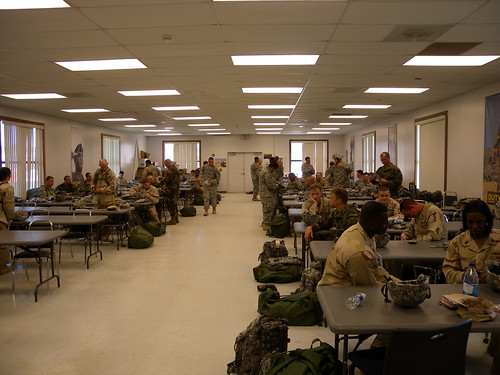
Day 2:
Some stuff....but this is when you get issued your weapons. Officers get both M16/M4 and M9. Enlisted get at least an M16/M4 but some get M9 as well. It depends on Noble Eagle number. Same with M4 vs M16. The M4 is issued if you'll be doing a lot of convoy ops. These weapons will be with you everywhere except the M16 doesn't go to the head with you (for some reason the DS's call it a latrine. Go figure ;)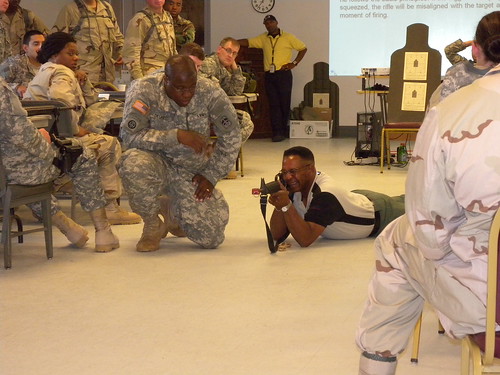
Day 3:
After day two, the focus is pretty much on shooting and safety. We got a lot of range time. Before we went to the range, we went to the Engagement Skills Trainer.
Think duck hunt or some other computer game. They had M16's, M4's, M9's and about any other weapon, in these things. We used the EST to learn how to group and zero our rifles. We also used it to do our low light M9 training. They use compressed air to operate the actions on the weapons and the computer makes the process foolproof. It is, however, also unforgiving.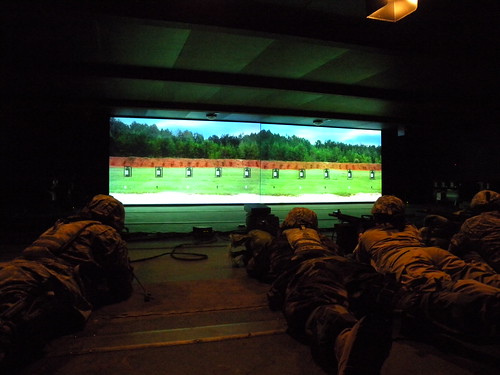
We finished this day off by going to the HEAT trainer. This is a HumVee egress trainer for rollover situations. You get in and everything is normal. The trainer leans one way a few degrees (OK...a lot of degrees), then the other, then it flips over onto its top. Now you're hanging upside down by your seat belt and have to safely get out and post security to your corner. Following this we got a familiarization lecture on the HumVee, followed by a change to rotate through the different positions to get a feel for it.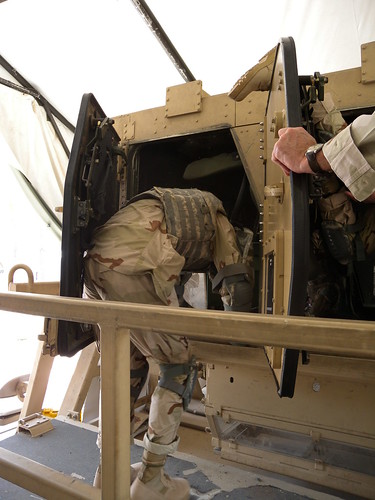
Day 4:
Our first day on the range, we started off with M9 quals. Yep. The first thing we did with real ammo was qualify on the M9. This was bad for people required to qual on the M9 who have never shot a handgun before. This was the Navy qualification course and it was in full battle rattle (Integrated Body Armor and ACH). I'm just glad I pulled off the expert marksman qualification. It would have been embarrassing if I didn't, since I was an pistol instructor (M1911 handguns) back at the Naval Academy so many years ago. It may have helped that I bought an M9 (Beretta 92FS) a few months ago and put 500 rounds downrange to get the feel for it. I was also smart enough to practice some of the finer points of the Navy qualifications.
Then we dropped our battle rattle in platoon formation (OK, we dropped it anywhere we felt like it and they made us move it into platoon formation) and proceeded to group and zero our M16/M4's "slick". This would be the last time we shot without armor. Did I mention armor is heavy? Shooting prone in the armor can be very difficult, too. The ACH tends to get pushed down over your eyes.
The next day we headed out to LOMAH. This is a computerized instant feedback range. We were shooting popup targets at various ranges out to 300 meters. Using sensitive microphone arrays, they are able to track the flight of your round and show you on a screen where you are hitting (or missing).
Sadly, we weren't shooting the whole time we were on the range. There is a lot of "white space". They try to fill it with concurrent training, which is a good thing. Looking back, it really seems the first two weeks are focused on shooting. There were a few things here and there that weren't, but not many. It may not help that we had one and a half range days wasted by power outage. The first day they didn't get power back until noon. We had already taken buses back to Camp McCrady. So...we got back on the buses and went to shoot. The next day it happened again. Instead of busing back to McCrady, we stuck around...and the power never came back on. This was qualification day. It also happened to be the coolest day in the first two weeks. It would have been ideal to qualify. It was "great" weather and the qualification process sounded fun - pop up targets at ranges from 50 to 300 meters.
These pictures were from the pre-qualification range. The DSs were of the opinion that whatever score you got here, you could probably add 5 or 6 to figure out how you would do for final qualification. The reason? Two things. First, the targets were spread out more. There's a lot more left and right, making it harder to recognize certain targets popped up. This is especially true with the 50m gimmes. The second is the contrast. All of these targets are dark. That makes it harder to see and aim at some of the more distant targets. I got over 30 on two out of three rounds. Things were looking good for qualifications.
Instead we ended up coming back and qualifying on Alt "C". Alt "C" is the alternate qualification method. Take the targets that are part of the normal qual range, and put appropriately proportioned facsimiles on a paper target at 25 meters. Some say it is easier. I thought it was less engaging and less realistic, and therefore it garnered less attention from those of us who were not required to qualify on the M16.
In fact...every day that we went to the range, we were at heat category 5 before we got to pull a single M16 trigger. That would also be known as "black flag". You can guess how comfortable it was to wear full body armor in 95-100 degree heat that is up near 110 with the heat index. The washer and dryer in our barracks worked until after lights out every day so we weren't hanging any soaked uniforms up. We're men, but we didn't want the barracks to smell like a locker room. Take a look at the thermometer ;)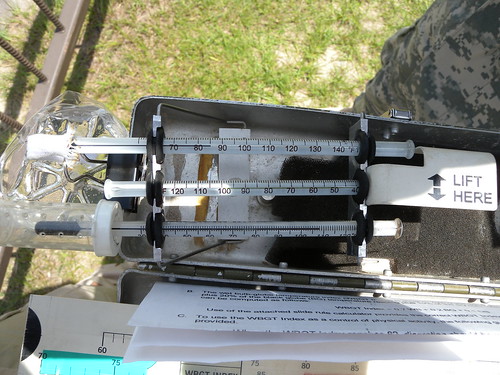
Somewhere in the rifle range white space, they had us in a classroom at the end of the day and taught basic "commo". We got a quick intro on setting up a SINCGARS radio and how to create and send a couple of signals (9 line medevac, and SPOT/SALUTE). The next week we had a practical application where we were broken up into teams of two and had to remember how to set up the radio, create the 9 line, and send it.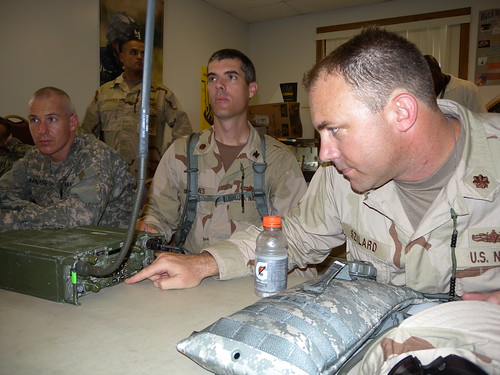
Once we got that done, we were given verbal directions on how to put on our JList. That's MOPP gear for the Navy types. For everyone else, that's our chemical, biological, radiological warfare suits. We had 3-5 seconds to put on our gas masks, then up to 8 minutes to put the suits on. It's Army Easy, so I was done in less than 3 minutes. My training at Ft McClellan in 1996 may have helped here, too.
Somewhere in week two we did the M9 Stress Fire (aka Table 3). This started with running in place 30-60 seconds. Then you have to pay attention and shoot the targets in the order the DS gives you (three targets to be engaged up to four times per position). You have one 6 round magazine loaded, and two in ammo pouches on your armor.
The first position is standing with optional support from a post/wall - fire two shots into the targets as ordered.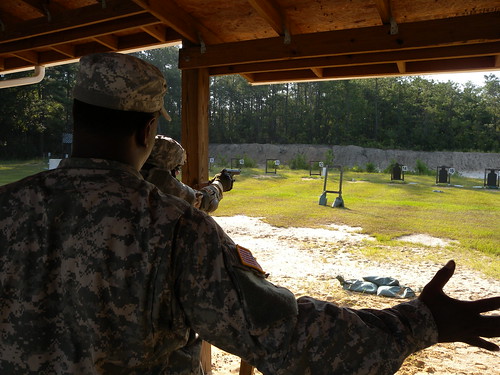
Then you transition to the prone where you fire four shots, rapid combat reload.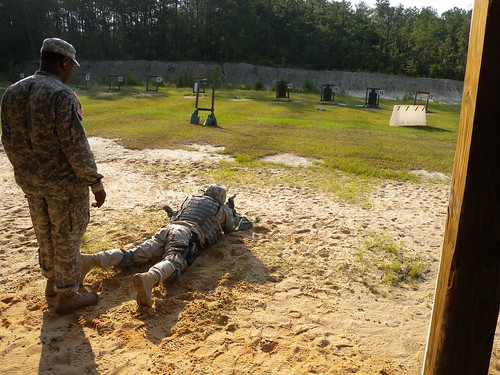
Move from here to the window, shooting through the window frame without "flagging" your position. This means you and the weapon stay "inside" the room so no one outside can see the weapon and possible pull it or you through the window. Shoot four shots through the window.
Next transition is to the barrier. Fire two shots over or around the barrier while taking cover. Combat rapid reload, then take two more shots.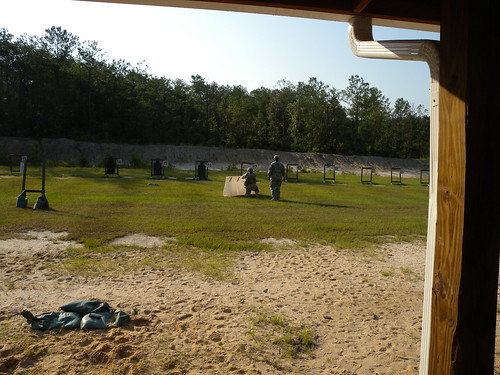
Transition from here to three meters from the targets, and from a standing position fire four point blank shots into the targets in the order given...usually finished with a double tap.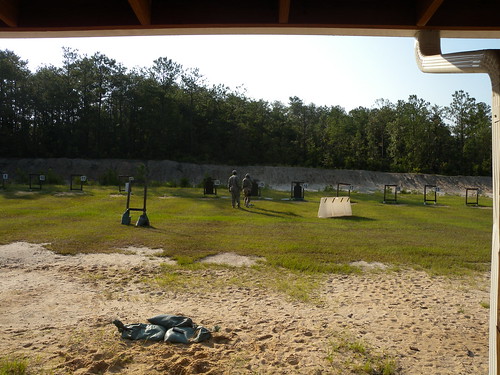
Here's a video I took:
The last things we did on the range were the M16 Stress Fire and the M16 Reflexive Fire. The M16 reflexive fire was relatively simple, but incredibly dangerous. 30 shooters line up on the range in groups of three. M16s are locked and loaded, carried at the low ready. At the range master's direction, you are told to face a certain way, then move as appropriate to engage the target with a controlled double tap using combat aiming - point the gun in the general direction and pull the trigger (you're close enough you shouldn't miss). We started facing straight and engaging the target by raising the rifle and shooting. Then we did a left face. Now the target was on our right. On the RM's command, we would engage the target. This means pivoting back to the front to keep the strength of our armor toward the threat, then raising the rifle and shooting. After firing two shots, we lower the rifle and pivot back to the left. If someone raises their rifle before pivoting the first time, or forgets to lower it before pivoting back, there may be a loaded rifle pointing at one of your body parts. Did I mention some of these people had never touched a gun before week one? Anyway, you go through this at different distances - 25 meters down to 5 meters.
The M16 Stress Fire was a little like the M9 Stress Fire...but more fun. We started by climing into and out of the back, then front, seats of the HMMVW (HumVee) they brought over. While in the HumVee, two of the DS's were yelling at us and making us "hurry".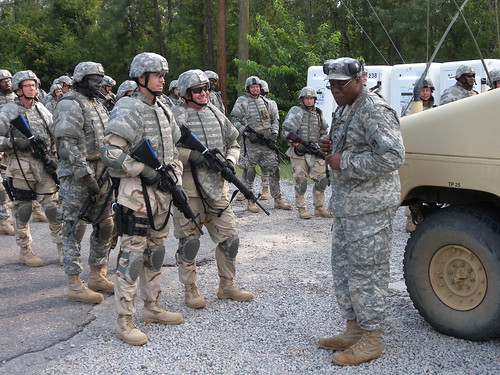
I may have had issues with keeping a straight face. USNA kept me from taking it too seriously.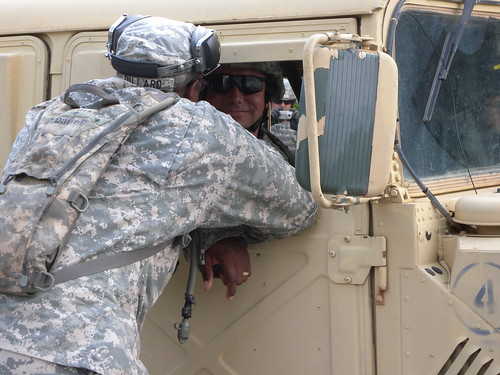
Coming out of the front seat, you had to sprint to a staging spot and take a knee. When the DS's with ammo were ready, you had to sprint there and take a knee. As they were giving you ammo that had to be put in cargo pockets, they were yelling and trying to cause stress. They were also prone to trying to take your weapon. If you let them, you got into a new world of hurt and had to do one or more things to get it back.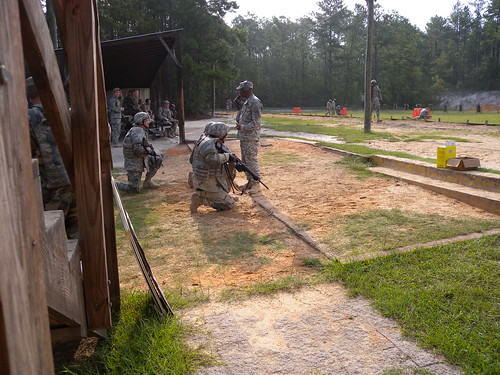
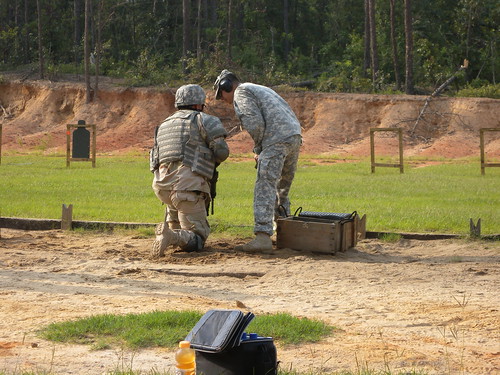
Once you got past these DSs, you headed to the first barrier. Here you engaged with two double taps from a standing position.
When safe, you proceeded to the next barrier. Shots here were from the prone position - two double taps.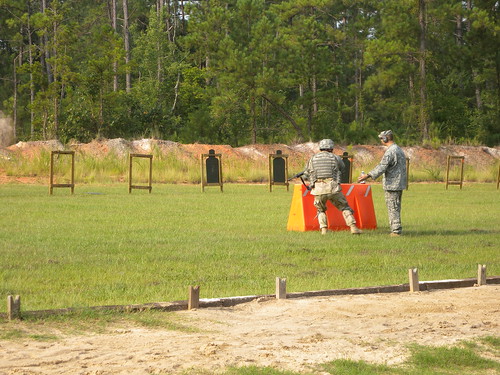
Now you moved to the next barrier, firing a double tap from the kneeling position followed by a rapid combat reload and another double tap. The final transition is to the last barrier where you unload the remaining rounds in controlled pairs. This was fun :) And, apparently I moved to fast. My photographer couldn't keep up and didn't get pictures of me at each station. I did, however, get a video of one of the other guys from getting ammo to empty.
The last week is all about the convoy. Front end training is on Monday, to include an IED "petting zoo" where you get to see different types of IEDs, learn what signs to look for, etc. You also get to do a training convoy with 5 HumVees per convoy. On the second convoy day, you do the convoy practical which can include IEDs, actors in appropriate clothing to act as both combatants and non-combatants, and other fun stuff.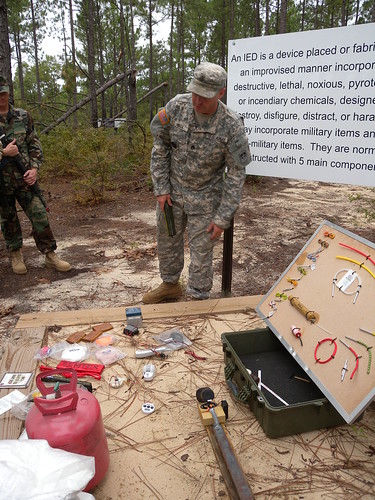
Then it's off to your next destination...Iraq, Afghanistan, or where ever the Narmy sends you.
I apologize for losing track of the days. I started off with good intentions to keep accurate dates...but it's close enough.
Sunday, August 1, 2010
Individual Augmentee or IA
That's the name given to someone in the Navy going to Iraq, Afghanistan, or some other place to help out the other armed services. Well, it's my turn now. This post is the story of what it was like to make the 5 (or 7) day transition from reServist to Active Duty Navy. The story actually starts at Day -2, but that was uneventful. I'll start with Day 1.
Day 1:
Showed up by 0730 per the orders. Apparently some people got word to show up by 0545. Didn't have time to get uniforms fitted prior to heading to the auditorium for briefs (about 0815). There were a couple of times that groups were singled out to stay in the auditorium. Others were able to take a break during those times. I was in the group that had to stay at every break. Didn't get out of my seat until 1140 when they sent us to lunch to return by 1230. Did I mention most of the morning briefs were a rehash of the ECRC checklist?
After lunch we were told we could go get fitted for uniforms during the first brief. We waited for the fitting folks for about 20 minutes. After they got there and got started, we were told to do it the next day and head back to the auditorium. Maybe 10 people had been fitted at this point. Some of us opted, based on the morning briefs, to get fitted before going back. It seemed like a good choice.
A couple more briefs finished off the day, except for being broken up into our groups. We waited as a CS1 read off the four groups using everybodies last 4, and each person responded. They were then told whether or not they had to fast for a blood draw. A little tip...those who had the most to get done had a 0615 muster. The next group was 0630. Those of us who completed things ahead of time were given 0730.
Day 2:
Medical. Did I mention medical? You basically bounce around medical all day.
Day 3 and 4:
Check in at 0800. Go home. Oh...maybe get fit for a gas mask. Then go home.
Day 5:
Get your uniforms and your travel brief. We congregated in the courtyard of the BEQ until our uniforms were ready. Then we inventoried the sea bag of uniforms and ensured everything fit properly. The problem? No one knew just how the ACUs had to look, so some uniforms ended up being exchanged when we got to Ft Jackson.
Day 7:
We flew out of NAS North Island at 0845 on Sunday. We had a 0615 show time at NMPS to get transported by passenger van to NASNI. The flight was a USMC C-9. We landed in Topeka for fuel. We landed in P-cola to drop some people off (another group of PAX headed in the same general direction) and fuel. Then we landed in Columbia, SC, where one of our buses broke down so we had to wait for another. We got in to Camp McCrady after the DFAC closed, so we got bag lunches while we sat through some introductory presentations. Some time after 8pm, we made it to our barracks where we got to settle in and hope we could sleep...before the 0500 wake up for Monday morning.
That's enough for now. Thanks for reading if you're still here ;)
The next post will talk about the next two weeks and includes pictures. Heh.
Time flies
Wow...it's been a day or two since I posted anything here. There will be some to come about my last few weeks of Narmy training!!